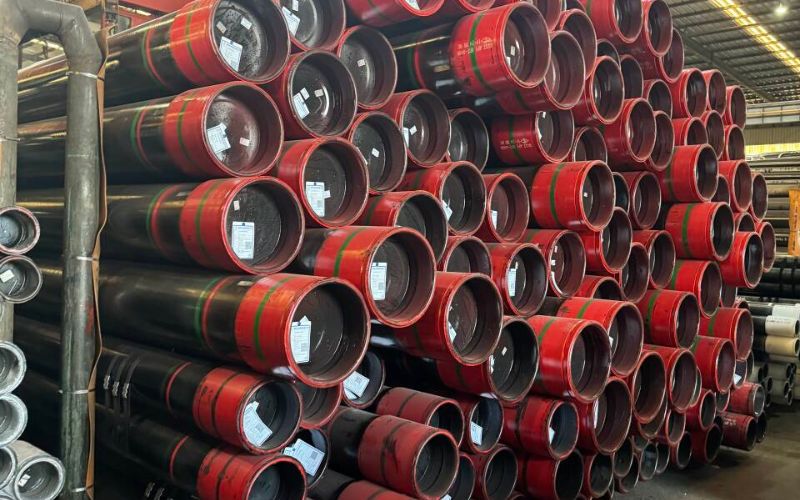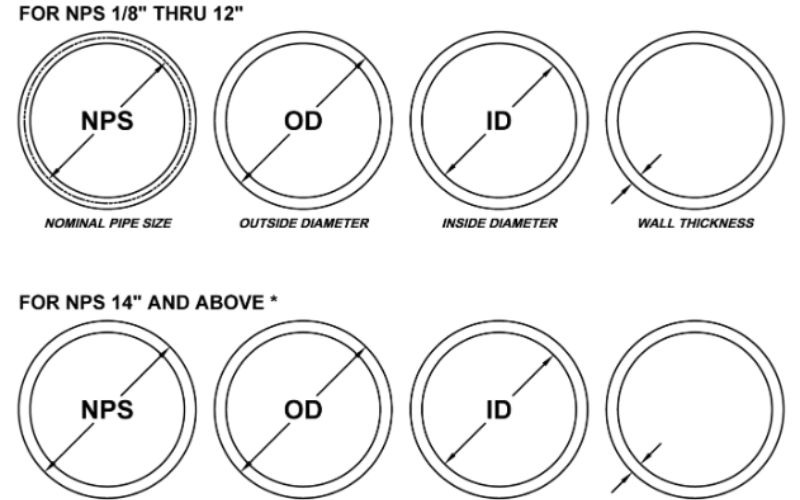When talking about piping systems, it is essential to understand the finer details of pipe sizing to maintain efficiency, safety, and good working conditions- all depending on industrial, commercial, or residential applications. From choosing the right nominal pipe size to ensuring allowances for the wall thickness, and key standards for sizing-gaining knowledge about these topics could translate to profit or loss. This booklet delves into all the basics of pipe size charts, colorfully explaining the complex jargon and enabling you to make a solid, informed decision on your specific requirements. Whether you are an industry person or an inquisitive learner, the article provides an easy-to-follow path to covering the fundamental concepts of pipe sizing. Now, let’s unfold these technicalities and give practical applications real meaning.
Introduction to Pipe Size Charts
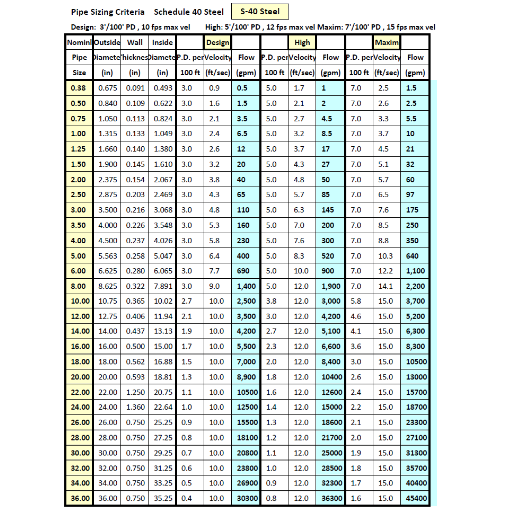
A pipe size chart is an important tool used to figure out the necessary sizes of pipes for various applications. It carries vital data such as the diameter of the pipes, thickness of the walls, and carrying capacity, out of which the right size can be chosen based on flow requirements and pressure tolerance. These charts focus on simplifying calculations by presenting common data, thus increasing accuracy and efficiency during planning. If one pays due care to these charts, he is ensured that pipes will not be under-sized or over-sized, with all undesirable consequences connected to either choice.
The Importance of Accurate Pipe Sizing
The right pipe sizing is fundamental in maintaining efficient fluid flow, system performance, and for saving huge amounts on avoidable errors. Velocity of fluid, pressure loss, material characteristics, and independent requirements of the application are some of those determining pipe size selection. Industry standards issued by such agencies as ASME, ASTM, etc., help engineers to determine the correct size using criteria based on such parameters.
For instance, typical water systems maintain flow velocity between 3 to 8 ft/sec to balance efficiency and erosion of system components. If these values are exceeded, the life of the pipe can be severely degraded due to friction loss that results in vibration and noise levels in excess of permissible levels. Moreover, gas piping usually takes into account different factors in compression and pressure drops, as they are greatly significant in affecting delivery rates over long distance. Generally, adequate size ensures reliability and safety, especially for a high-pressure system.
Wall thickness and material compatibility are other items essential to be understood. Thin wall pipes such as copper and PVC are preferred for low-pressure applications since they are cheaper to buy and easy to handle. While at the same time, the thicker and more aggressive materials should be employed where conditions are high pressure or adverse. When such information is applied during the design, it will go a long way in minimizing maintenance cost and operational hazards.
Being conscientious through the study of these factors can make even better men work fittings to an optimum level, whether it is plumbing infrastructures, industrial piping, or HVAC systems.
Overview of Pipe Dimensions and Specifications
Understanding the dimensions and specifications of pipes is critical to choosing the correct materials for use in an application. Pipes are generally described by their nominal diameter (ND) or nominal pipe size (NPS), wall thickness, and schedule numbers. The nominal diameter refers to the approximate inside diameter of a pipe. Depending on the type and use of the pipe, normal diameters range from 1/8 inch to up to 48 inches. The wall thickness is designated by the schedule number, such as schedule 40 or schedule 80. This actually determines the strength and pressure rating of the pipe. A schedule 80 pipe has walls thicker than a schedule 40 pipe and can hold pressure better.
Also, materials influence pipe selection. Common pipe materials include carbon steel, stainless steel, PVC, and copper, each bearing its specific use. Carbon steel pipes are heavy-duty and used mainly for industrial and construction applications, while stainless steel pipes are known for their corrosion resistance, particularly in chemical and food processing applications. PVC pipes, which are lightweight and versatile, are generally used for residential plumbing and irrigation. And copper, being very durable, is great for water distribution applications.
Temperature tolerance, pressure rating, and compatibility of the material with the one being transported are the important factors in pipe selection. On an example basis, stainless steel pipes could work well in temperature ratings of a little high, whereas the PVC pipes are meant for cold water and moderate pressure. Also, these measures such as pipe OD and pipe ID are standardized in most cases so that they fit during installation in systems of compatibility.
With the aid of specific pipe standards, engineering professionals make wise decisions that go into the safety and efficiency of piping systems throughout their lifetime. Dimension and material selected will, therefore, best suit piping systems for optimized functioning for a particular work.
Applications of Pipe Size Charts in Industries
Pipe size charts are widely used in industries for selecting appropriate pipe dimensions, ensuring compatibility, and optimizing system performance.
| Key Point | Description |
|---|---|
|
Sizing |
Select correct pipe dimensions |
|
Flow |
Ensure optimal fluid flow |
|
Pressure |
Match pressure requirements |
|
Material |
Choose suitable materials |
|
Standards |
Adhere to industry standards |
|
Cost |
Optimize cost-efficiency |
Understanding Pipe Measurements
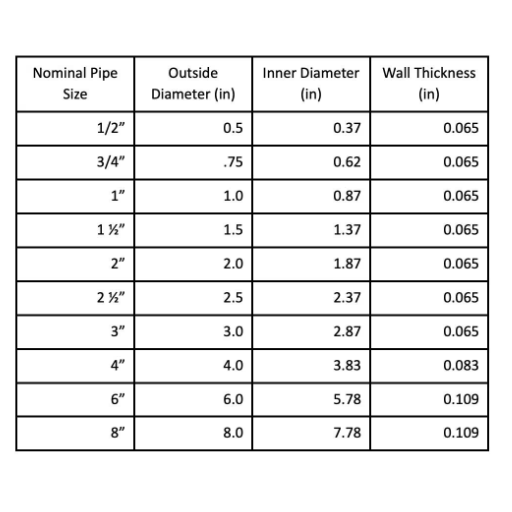
Pipe measurements are determined by three factors: NPS, OD, and ID. The NPS refers to the nominal size designation of the pipe, which is not always equal to the actual dimensions. OD stands for the outside diameter of a pipe, while ID is the inside diameter or the empty space within. These dimension measurements are essential to ascertain the correct fit of a pipe, its compatibility, and usability in any application. One should always refer to standardized charts or industry guidelines to confirm accuracy when it comes to measurement or selection of pipes.
Nominal Pipe Size (NPS) Explained
Nominal Pipe Size (NPS) refers to a standard designation used for identifying pipe dimensions, especially in industrial fields such as construction, manufacturing, and plumbing. Despite the name, NPS does not specify an exact measurement of a pipe’s outside diameter (OD) or inside diameter (ID); rather, it is used as a convenient system for classification and sizing.
Unlike NPS. 14 and above, the outside diameter of the pipe for NPS 1/8 to NPS 12 is larger than the respective parent NPS number. For instance, NPS 6 pipe has an outside diameter of 6.625 inches about. Then, wall thickness stands out as a primary feature depending on the schedule-the thickness will reduce the inside diameter and so is the schedule-making high pressure or temperature applications critically important.
This piping nomenclature system has been widely accepted by industrial sectors primarily because of its consistency and correspondence with international standards such as ISO 6708, which defines nominal diameter (DN). Having detailed knowledge of these specifications-NPS, OD, ID, schedule-will ensure safety and efficiency during the execution stage and at the time of joining with other piping systems. Any project or engineering endeavor should practice adherence to standard dimensions, such as those provided by ASME, to have assurance in reliability and in being compatible with others.
Outer Diameter (OD) and Wall Thickness
The term outer diameter (OD) refers to the diameter measured across the widest point of the outside surface of a pipe. Once set for a nominal size of pipe (NPS), OD remains constant irrespective of the thickness of the pipe’s walls. On the contrary, a wall defines the thickness of the pipe material and greatly affects the strength and pressure capacity of the pipe. OD and wall thickness together decide the inner diameter (ID) of the pipe, which in turn determines the flow capacity and efficiency of a piping system.
To achieve standardization and versatility, industrial standards have fixed definite OD and wall thickness measurements. For instance, a standard NPS 6 pipe has an OD of 6.625 inches. But depending on the schedule, such as Schedule 40 or Schedule 80, the wall thickness varies, thereby affecting the ID and pressure ratings accordingly. For calculations, Schedule 40 pipes generally have a thinner wall than Schedule 80, the latter being used for higher pressure. This exactness in dimensions and variations enables integration within piping systems across the world, considering temperature, pressure, and material stresses.
Knowing OD and wall thickness is important so that the right pipe dimensions can be chosen for opposite needs, whether the pipe is transporting liquids, gases, or solids. These two dimensions together hold the key to resolving system performance and safety issues.
Pipe Schedule and Weight Designations
Pipe schedules and weight designations are vital specifications in the pipeline industry to design a pipe in terms of strength, longevity, and usability for certain applications. The term “pipe schedule” implies the wall thickness of the pipe. It is denoted by a number, for example, Schedule 10, 40, or 80, which has a corresponding correlation to the pressure rating within the pipe. In pipe specification, a higher number means that the pipe wall is thicker and can, therefore, handle a high amount of internal pressure.
In general, Schedule 40 pipes are utilized primarily in residential and commercial plumbing owing to their moderate strength and higher versatility, whereas Schedule 80 pipes are usually specified on the industrial side, being of greater strength for high pressures. Also, weight designations, such as Standard (STD), Extra Strong (XS), and Double Extra Strong (XXS), show the overall strength and weight of the pipe, offering a further rationale for design engineers to consider.
The industry-by-industry uses standard charts indicating the nominal pipe size (NPS) with schedule and weight designations measuring. For example, a 2 in. NPS Schedule 40 pipe normally has an OD (outside diameter) of 2.375 in. with a wall thickness of 0.154 in., while in Schedule 80 the same dimension will have a wall thickness of 0.218 in.
By virtue of these classifications, one can select suitable pipes exempting from pressure, temperature, or material incompatibility, which make the installation unsafe or inept. Hence, the selection of pipe schedules and weight designation factors put the engineer toward the best pipeline performance across many industries, from oil and gas to water treatment systems.
Comparing Different Pipe Materials

Different pipe materials like PVC, PEX, copper, cast iron, and stainless steel vary in cost, durability, corrosion resistance, and application suitability.
| Key Point | PVC | PEX | Copper | Cast Iron | Stainless |
|---|---|---|---|---|---|
|
Cost |
Low |
Medium |
High |
High |
High |
|
Durability |
Medium |
High |
Very High |
Very High |
Very High |
|
Corrosion |
Resistant |
Resistant |
Resistant |
Prone |
Resistant |
|
Flexibility |
Low |
High |
Low |
Low |
Medium |
|
Use |
Drainage |
Plumbing |
Water Supply |
Sewage |
Industrial |
|
Temp. |
Low |
Medium |
High |
Low |
High |
Characteristics of Steel Pipe
Steel pipes are a shining example of durability and versatility with a high strength-to-weight ratio-prime attributes that lend themselves to cross-industrial applications. One major characteristic of steel pipes is internal and external pressure resistance due to high tensile strength, thereby making them ideal for transporting fluids and gases under high pressure.
Another good property steel pipes have is the resistance to thermal expansion and contraction, meaning they can work well under different temperature conditions, be it extreme heat or frost. Depending on the alloy composition of the type of steel pipe, they can offer good corrosion resistance as well. For example, stainless steel pipes with a minimum of 10.5% chromium content act by a chemically passive layer of chromium oxide that protects against rusting. Thus, they are best suited for corrosive environments such as chemical processing plants.
Steel pipes can range in diameter and wall thickness tremendously. For instance, seamless steel pipes find application in industries demanding stringent dimensional tolerances like aerospace and automotive manufacturing. Welding of steel pipes, e.g., electric resistance welded (ERW) pipes, presents a more economical consideration where seamless cannot be justified.
Yet another favorite trait of steel pipes is the weight-to-strength ratio. These heavy-gauge pipes can help save money in the long run thanks to their longer life and lesser maintenance. Besides, recycling steel pipes adds great value to the green environment and promotes eco-friendly practices that industries across the globe are concentrating on.
With all these attributes, steel pipes are still bearing the wire across construction, energy, and water management to offer conspicuous infrastructure and industrial development options.
Stainless Steel Pipe vs. Carbon Steel Pipe
Stainless steel pipes resist corrosion and are visually appealing, while carbon steel pipes are cost-effective and suitable for high-temperature applications.
| Key Point | Stainless Steel | Carbon Steel |
|---|---|---|
|
Corrosion |
Resistant |
Prone to rust |
|
Appearance |
Shiny |
Matte |
|
Strength |
Durable |
High heat tolerance |
|
Cost |
Higher |
Lower |
|
Use |
Hygienic, visible |
Hidden, structural |
|
Material |
Chromium, nickel |
Iron, carbon |
|
Temp. |
Low conductivity |
High heat resistant |
Advantages of Using Tubing Versus Pipe
When evaluating the choice between tubing and pipe, it is essential to consider their defining qualities and applications. While both serve similar purposes in transporting fluids, gases, or other materials, tubing and pipe differ in their design, strength, precision, and flexibility, making them suitable for distinct uses.
- Precision and Dimensional Accuracy
Tubing is manufactured with tighter tolerances compared to pipe, which means it offers greater precision in its dimensions. This makes tubing ideal for applications that require exact measurements, such as in medical devices, automotive components, and aerospace engineering. Precision tubing also supports smooth fluid flow with reduced risk of turbulence.
- Flexibility and Bendability
Tubing is often favored in applications requiring flexibility, as it can be bent or formed into specific shapes without compromising its structural integrity. This characteristic provides significant advantages in industries like HVAC systems, where tubing is used to create complex pathways for refrigerants and airflow.
- Weight and Efficiency
Tubing tends to be lighter than pipes due to its thinner walls, which translates to reduced material usage. For applications where weight is a major consideration, such as in construction scaffolding or the manufacturing of lightweight machinery, tubing offers a highly efficient alternative to traditional piping.
- Strength-to-Weight Ratio
Despite its lighter weight, tubing often maintains a high strength-to-weight ratio. Stainless steel tubing, for example, combines corrosion resistance with mechanical durability, making it an excellent choice for high-pressure or high-temperature uses like hydraulic systems and fuel lines.
- Standardization and Versatility
Pipes are typically measured by their inside diameter (ID) and intended mainly for transporting fluids. Tubing, conversely, is measured by its outside diameter (OD) and finds a broader range of applications including structural, mechanical, and decorative purposes. This versatility gives tubing an edge in industries that demand multifunctional components.
- Ease of Connection and Maintenance
Many tubing options are designed for quick connection and disconnection, facilitating easier maintenance and repair processes. This aspect is particularly useful in laboratory environments and industrial settings where minimizing downtime is crucial.
- Cost Considerations
While tubing may require more advanced manufacturing processes compared to pipes, its efficiency in material usage, lighter weight, and long-term durability can lead to cost savings over time. Its reduced need for frequent replacements and repairs often offsets the initial investment.
For instance, in the automotive industry, seamless stainless steel tubing has demonstrated significant contributions in reducing vehicle weight by about 25-30%, enhancing fuel efficiency without sacrificing safety. Similarly, the use of copper or aluminum tubing in refrigeration systems has led to a 15% boost in energy efficiency due to their superior heat conductivity.
These advantages demonstrate why tubing is favored in specialized applications, whereas pipes remain the preferred choice for standard fluid transportation needs. Understanding the strengths of each ensures optimal selection for specific use cases, improving performance and efficiency across diverse industries.
Pipe Sizing Standards Across Industries
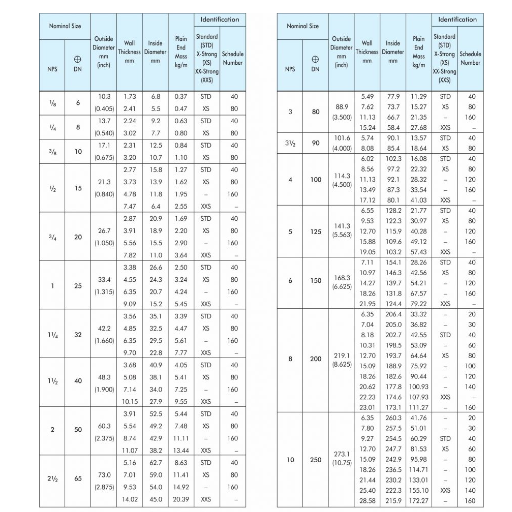
Pipe sizing standards vary according to the specific parameters involved in the respective industries, ensuring safety, efficiency, and reliability. Some of the commonly accepted standards are as follows:
- American National Standards Institute (ANSI): Different sizes and tolerances of pipes are defined according to their application in power generation, maintenance, and construction.
- American Society of Mechanical Engineers (ASME): It concerns itself with pressure piping, covering materials, design, and testing in detail.
- International Organization for Standardization (ISO): Provides international specifications for pipe sizes that ensure the compatibility of products across international projects.
- American Petroleum Institute (API): Pipe sizing for oil and gas applications that consider durability and operation under high pressures are key concerns.
These standards promote consistent engineering, greater safety, and improved performance across the industries.
ANSI Standards for Pipe Sizing
Standards imposed by the American National Standards Institute (ANSI) make pipe sizing rigorous and consistent across industries. Standards such as ANSI B36.10M for welded and seamless wrought steel pipes give specific details of dimension, wall thickness, and tolerances for industrial use. For instance, it is stated that a pipe named NPS 6 schedule 40 will have an outer diameter of 6.625 inches and wall thicknesses of 0.280 inches, which translate into a corresponding inner diameter vital for fluid dynamics.
Clearly, the ANSI standards also allow greater interoperability as the ANSI standard is generally in harmony with other recognized standards like ISO, easing global operations. Hence, in a wide range of industries, including chemical processing, power generation, construction, and water processing, where issues of safety and reliability are paramount, ANSI pipe sizing is used. In fact, sizing pipes according to ANSI standards ensures structural integrity, efficient use of available resources, and ease of maintenance and repair, thus mitigating the chances of hindrance to operation. Hence, the very adherence to these exact standards helps industries become compliant and operationally proficient.
Common NPS Tables and Their Uses
Common NPS tables and their uses include dimensions, wall thickness, and schedules for various pipe sizes, aiding in selecting appropriate pipes for specific applications.
| Key Point | Description |
|---|---|
|
NPS |
Nominal Pipe Size |
|
DN |
Diameter Nominal |
|
OD |
Outside Diameter |
|
ID |
Inside Diameter |
|
Sch. |
Schedule (Wall Thickness) |
|
STD |
Standard Weight |
|
XS |
Extra Strong |
|
XXS |
Double Extra Strong |
|
Material |
Pipe Material Types |
|
ISO |
International Standards |
International Pipe Sizing Standards
International pipe sizing standards serve as a common denominator, ensuring consistency in design, safety, and compatibility of industrial requirements across nations. I have always felt these standards are deemed important to smooth out any shared working relations between countries with dissimilar engineering practices. Standards issued by ISO (International Organization for Standardization) and DIN (Deutsches Institut für Normung) channel specifications for diverse materials and dimensions, offering maximum compatibility on the selection, installation, and maintenance of pipes. Working in conformity with these recognized systems worldwide would bring about efficiency in working, with minimal chances of errors, and keeping with internationally accepted best practices.
Common Mistakes in Pipe Sizing
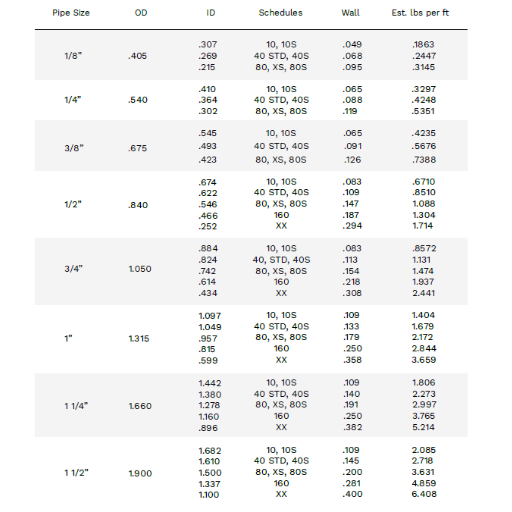
1. Oversizing the Pipe
Trying to select larger pipe sizes than required will only have negative consequences: one will buy more material; another will reduce the flow velocity needed for sediment to accumulate or for the system to underperform.
2. Undersizing the Pipe
Excessive pressure losses, loss of flow rates, stresses to equipment, and finally damage to the system are likely to occur when under-sized pipes are being used.
3. Ignoring Pressure Loss Factors
Leaving pressure losses to friction, fittings, and elevation changes out of account will cause the sizing of the system to be wrong and without efficiency.
4. Neglecting Future Demands
Lack of consideration of the grow or usage within a short period after design may lead to capacity problems and another consideration for the installation to be costly.
5. Assuming Universal Fit
Different standard or systems should crap different views linking pipes and fittings inducing leakage or wrong connections if not suitably matched.
By ensuring these faults are excluded and were accompanied by appropriate calculations and tools, the systems may thus run efficiently and avert additional failures or expenses.
Misunderstanding Pipe Wall Thickness
A common mistake under system design considerations is the underestimation of the importance of pipe wall thickness. The thicker the wall of a pipe, the more strength, durability, and resistance to internal pressure it possesses. Using underthick pipe cases for an application of a certain nature can lead to some catastrophic failures, due to bursts or leaks, particularly under high-pressure conditions. For example, in systems working under pressure beyond 1,000 psi, pipe usage recommendations sometimes favor thicker-wall piping from a standpoint of safety or through ASME B31.3 codes or ASTM Standards.
Wall thickness may trigger a difference in flow rate through diameter of pipe and internal space for fluid movement, i.e., a thicker wall implies a bit of reduction in the internal diameter, which may pose an increase in resistance and pressure drop across distance. Engineers arrive at a suitable wall thickness by analyzing variables such as fluid type, pressure, temperature, and strength of the material. Even for something like stainless steel pipe used in chemical applications, additional thickness may be required so as to withstand corrosion over time while gaining sufficient structural integrity.
Choosing the wrong thickness could bring hazards and decrease functional goals. If followed with standards and calculations summarized, definitely the operational infrastructure would be best in safety and effectiveness. It is exceedingly critical to evaluate these parameters to reduce chances and thus avoid system downtime.
Incorrectly Interpreting Pipe Schedules
Piping systems often have the same common problem of pipe schedules being misunderstood, with heavy consequences for performance, safety, and generation for the whole system. In the piping industry, the term “pipe schedule” refers to pipe scenario wall thickness and is useful in assessing its pressure rating or suitability for operation. Misunderstanding pipe schedules can lead to making an incorrect selection, resulting in a pipe failing under design pressure, particularly under high-stress circumstances, such as conditions in industrial processing or high-temperature systems.
For instance, Schedule 40 pipes are among those most commonly used since they provide a good compromise between strength and material economy. Thicker wall pipes of Schedule 80 or higher would be required in processes needing higher pressure resistance, such as oil and gas operations. Such charts that list pipe schedule against pressure rating, wall thickness, and grades of material are key working tools and must not be misread. Quite commonly, errors in design have risen from confusing nominal pipe size (NPS) or from confusing one type of material to another, such as stainless steel and carbon steel.
The ASME rules relate each schedule to a given pressure-temperature rating for given materials. For example, Schedule 80 carbon steel pipes are capable of taking pressures over 2,000 psi depending on diameters, whilst stainless steel pipes are often more than this for the same schedule. Correlating these ratings to actual operational requirements, however, is the very essence of engineering before applying them.
Overlooking the Impact of Material Type on Sizing
Material type has a critical impact on good engineering or construction projects in deciding the proper pipe diameter. Individual materials—be it steel, copper, PVC, or composite materials—have different sets of physical and chemical properties that determine how they behave under several conditions.
Steel pipes are renowned for their strength and durability; hence, high-pressure systems are among the few applications that justify their usage. These pipes are very heavy and prone to corrosion in some environments, thus requiring some forms of coatings or linings. PVC pipes are lightweight, resistant to corrosion, and simple to install; however, pressure capacity and heat tolerance are some limitations. Recent studies revealed that pressures in excess of 1,000 psi could be sustained by steel pipes, whereas, depending on specific grades, most PVC pipes are considered best if used under 300 psi.
Thermal expansion is yet another aspect to be given consideration when looking at material-related selections. One example is that PVC or plastic in general has a higher coefficient of thermal expansion when compared to metals such as steel or copper. Therefore, an environment that provides fluctuations in temperature can cause plastic pipes to expand to a great extent and compromise their dimensional stability. This phenomenon compels engineers to make arrangements for expansion joints or allow for sufficient space during installation.
Also, resistance toward chemicals concerning exposure has to be in alignment with specific applications. For example, copper pipes are esteemed in potable water delivery because of their antimicrobial effect but may corrode when carrying highly acidic or alkaline fluids. With growing importance, thermoplastics such as CPVC are increasingly being used for chemical handling systems because of the broad range of chemicals they resist.
Not taking into account the factors of material properties vis-à-vis operating conditions could adversely result in systems that are either undersized or over-engineered, both of which are sales points for risk and cost. By taking advantage of the updated material guidelines and analysis supported by observation and figures, we ensure the chosen pipe material is the best for the purposes it is designed for.
Reference Sources
- Economic Pipe Size Selection Chart
- Author: J. Keller
- Type: Conference Paper
- Publication Year: 1975
- Citation Token: (Keller, 1975, pp. 109–121)
- Summary: This paper presents a chart for selecting economic pipe sizes, which is crucial for optimizing costs in engineering applications. However, it is important to note that this paper is quite dated and does not fall within the last five years.
- Effect of Pipe Size and Location on Water-Main Head Loss in Water Distribution Systems
- Authors: Saeed Hashemi et al.
- Type: Article
- Publication Date: June 1, 2020
- Citation Token: (Hashemi et al., 2020)
- Summary: This study discusses the practical implications of considering unit head loss in different pipe sizes and locations within water distribution systems. The authors conducted experiments to analyze how variations in pipe size affect head loss, which is critical for efficient water distribution. The methodology involved both theoretical calculations and empirical data collection to assess the impact of pipe dimensions on hydraulic performance.
- Hydrate Management in Deadlegs: Effect of Pipe Size on Hydrate Deposition
- Authors: Xianwei Zhang et al.
- Type: Article
- Publication Date: February 20, 2020
- Citation Token: (Zhang et al., 2020, pp. 1422–1431)
- Summary: This research investigates the effect of pipe size on hydrate deposition in deadlegs of piping systems. The study utilized computational fluid dynamics (CFD) simulations to model hydrate formation and deposition under various conditions. The findings indicate that pipe size significantly influences hydrate management strategies, which is essential for maintaining operational efficiency in gas and oil pipelines.
Frequently Asked Questions (FAQs)
What is a pipe schedule chart?
A pipe schedule chart is a reference tool that provides information on the thickness of pipe walls and the corresponding pipe sizes. It helps determine the appropriate schedule (like schedule 40 or schedule 80) for various applications, ensuring that pipes can handle the required pressure and flow.
How do I determine the nominal pipe size?
The nominal pipe size (NPS) is a standardized way to designate pipe dimensions. To determine the nominal pipe size, you can use our ANSI pipe chart, which outlines the standard sizes and their corresponding outside diameters (OD) and wall thicknesses.
What are the differences between schedule 40 and schedule 80 pipes?
Schedule 40 and schedule 80 pipes differ primarily in wall thickness. Schedule 80 pipes have a thicker wall compared to schedule 40 pipes, allowing them to withstand higher pressures. This difference in thickness also affects the weight and schedule designations of the pipes.
What is the wall thickness of stainless steel pipe sizes?
The wall thickness of stainless steel pipe sizes can vary based on the schedule designation. For instance, a schedule 40 stainless steel pipe will have a specific wall thickness that is different from that of a schedule 80 stainless steel pipe. Referencing a pipe schedule chart can provide accurate measurements for various stainless steel pipe sizes.
How are pipe dimensions specified in millimeters?
Pipe dimensions can be specified in millimeters by using the DN (diameter nominal) designation, which is often equivalent to NPS sizes. For example, a DN 6 pipe corresponds to a nominal size of 1/4 inch, allowing users to convert between imperial and metric measurements effectively.
What is the importance of pipe weight in scheduling?
Pipe weight is crucial in scheduling as it determines the load-bearing capacity and structural integrity of the piping system. Knowing the weight and schedule designations helps engineers choose the right pipe for specific applications, ensuring safety and compliance with industry standards.
Can I use a pipe chart for different materials like steel or PVC?
Yes, a pipe chart can be used for various materials, including steel, PVC, and stainless steel. However, it’s essential to consult the specific pipe schedule chart for each material, as wall thickness, pressure ratings, and dimensions may vary significantly between them.
What are the NPS tables used for?
NPS tables are used to provide a comprehensive overview of nominal pipe sizes, including their corresponding dimensions, wall thicknesses, and weights. These tables help engineers and technicians select the appropriate pipe size for their projects based on the required specifications.



